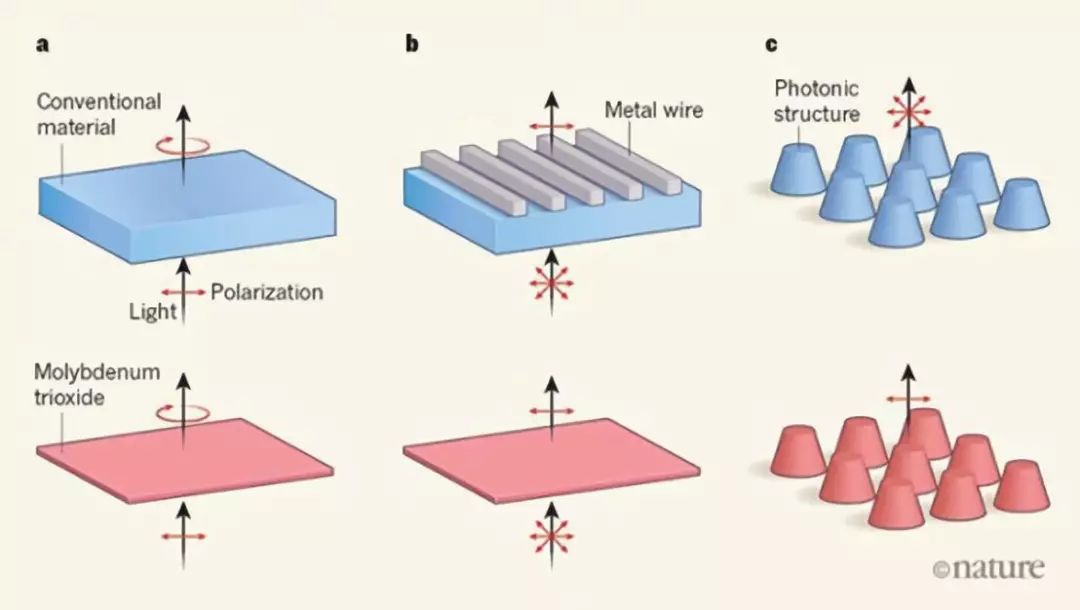In optical design, the design of infrared system is very different from that of visible light system, which is mainly reflected in the selection of optical materials. Considering the transmittance and other optical characteristics, infrared optical design often selects some special optical materials, such as various crystal materials. Many crystals have a birefringence property, which helps control the polarization of incident light. In practice, the crystal size required to achieve polarization control is proportional to the wavelength of incident light and the birefringence intensity, and the crystal thickness is in the order of millimeters for mid-far infrared imaging systems.
Recently, researchers have discovered a natural hyperbolic material with an extreme optical property known as in-plane hyperbolism, which could potentially make infrared optical components even smaller.
So-called hyperbolic materials are special materials that have an extremely high reflectivity along one axis and reflect light along a vertical axis, both of which are in the same plane. Such materials can be used to make optical components such as ultra-thin wave plates that can change the polarization of incident light. The reflective properties of this material allow light to be manipulated and confined within a very small size range. Originally found only in man-made materials, the hyperbolic property was observed in a natural material called hexagonal boron nitride in 2014. The reflection behavior of both hexagonal boron nitride and molybdenum trioxide comes from lattice vibration, that is, optical phonons that oscillate in a highly anisotropic manner, inhibiting the absorption of light by the material.
The researchers' study of molybdenum trioxide showed that the material has a hyperbolic property in the long-wave infrared, which can be used to limit light to a size much smaller than its wavelength by forming a mixture of light and material excitation called hyperbolic phonon polaritons, which have a lifetime up to 10 times that of the longest life of hexagonal boron nitride. The crystal structure of molybdenum trioxide is highly anisotropic. The length of the three crystal axes of the crystal is different, and the phonon energy and refractive index associated with these crystal axes are very different. Studies have shown that materials such as molybdenum trioxide can be used to precisely control the polarization of infrared light.

The element in panel b is a polarizer that converts unpolarized light into linearly polarized light. In the infrared band, polarizers made of traditional materials usually need to be very thick and use a lot of metal gratings. If molybdenum trioxide material is used, the same function can be achieved without grid wire.
Panel c shows a nanoscale photonic structure made of traditional materials, which generates unpolarized infrared light, and replaces it with molybdenum trioxide to produce linear polarization.
In addition to its use in optical components, this property of molybdenum trioxide could also lead to the development of nanophotonics, the confinement of light to the nanoscale scale. The nanoscale light limit necessarily means breaking the diffraction limit, and light cannot normally be concentrated to a size much smaller than its wavelength, but molybdenum trioxide can break through this limit, making improved infrared emitting devices possible.
Hyperbolic materials such as molybdenum trioxide can also be used as the basis for superlenses, which produce magnified images of objects with smaller wavelengths of imaging light. Such materials can also be used in heterostructures (structures that combine layers of different materials) to make nanophotonics components with controllable properties.
The existing research results have contributed to substantial progress in the field of infrared optics and nanophotonics, which may make infrared imaging and detection as common as visible imaging, enabling fluoroscopy of smoke, instant medical diagnosis, enhanced chemical spectroscopy and more.
在线咨询
phone
0379-63338608
0379-63338609
 CN
CN
